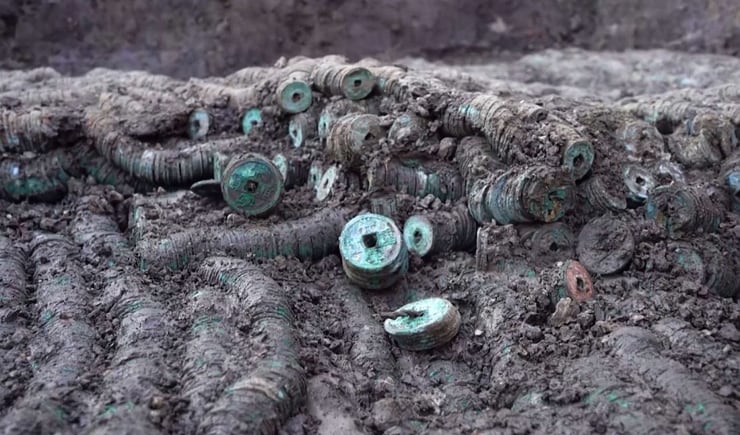👀👍 1,5 tuny? To bych nechtěl odnášet 😁
1500 kg of bronze coins half a metre underground
Categories: Nálezy nejenom s detektorem v Číně
A huge hoard of 1.5-ton bronze coins from the Tang (618-907) and Song (960-1279) dynasties was discovered in the eastern Chinese village of Shuangdun in Jiangsu province. The coins were connected by straw strings and arranged in neat rows.
The square pit in which the treasure was placed was 163 x 158 cm in size and about 50 cm deep. It was probably originally lined with straw or other organic material. The coins were very well preserved, carefully aligned and most bore still clearly legible inscriptions, which are now being examined and conserved by experts. The most common coins are bronze wens from the Song dynasty.
Coins of this type were the common currency of the time until a severe copper shortage forced rulers to mint coins of lower quality and value. Due to the shortage of bronze coins, the government was forced to cut military wages in half in 1161. Iron coins were not successful - they were difficult to mint and corroded very quickly in circulation. The currency crisis eventually led to the creation of paper money, and as early as 1170 the state began to require that half of all taxes be paid with the newly introduced paper currency, the Huizi.
The Sung Dynasty represented a time of stability and development. Paper money was printed by the first government in the world and the first Chinese government to establish a permanent navy. The Sung Dynasty also saw the first recorded use of gunpowder and the use of the compass. During this period of plenty, the Chinese population doubled.
The site of the find was near the frontline battlefield where Sung and Jin forces clashed. Whether the excavation site belonged to a military encampment and the coins deposited were intended to serve as military rations is a subject for further research.
Roman Němec
Sources: arkeonews.net, msn.com, xinhuanet.com




The article is included in categories:
- Archive of articles > Archaeology > Finds and rescue research abroad > Nálezy nejenom s detektorem v Číně
Post
To Venda17, spíš bych nechtěl být tím, kdo to pak bude čistit a konzervovat. Bych se po tisícáté stejné minci musel zbláznit😁.
To je fakt 🙈😁😁😁
áno, velký depot - a není to první čínský tunový nález
- možná byly mezi nimi i nějaký zhaona xinbao
- a k tomu železu a ostatnímu
https://en.wikipedia.org/wiki/Southern_Song_dynasty_coinage
https://en.wikipedia.org/wiki/List_of_Chinese_cash_coins_by_inscription
- a ještě otázka pro opravdové znalce
- mince se v tomto období razily, nebo odlévaly??
a něco paragrafů, jestliže se tam vydáte na lov
Article 34 of the Chinese Civil Relic Protection Law reads: “No entity or individual may take any of the cultural relics excavated into its or his own possession.” Article 12 says the state shall give “moral encouragement or material awards” to anyone donating “important cultural relics in one’s own collection to the state.” Article 53 authorizes the Department of Cultural Relics Administration to establish cultural relic shops through which certain objects might be offered for sale. Nowhere in the CCRP law does it specifically mention coins.
To si tam schoval Sun Wu-kchung....
abyste věděli...
slušný depot
toto je také zajímavé, samozřejmě z Číny
https://www.novinky.cz/clanek/veda-skoly-nejstarsi-mince-se-zrodily-u-zlute-reky-40374813
https://sciencemag.cz/nejstarsi-mincovna-ze-staroveke-ciny/
Tak to je mazec, to by nepřežil ani detík ani moje pumpička 













